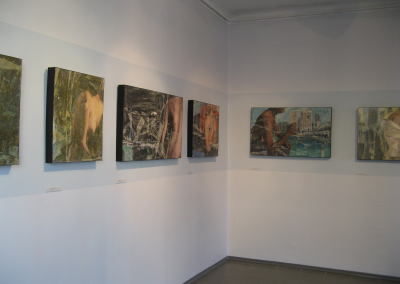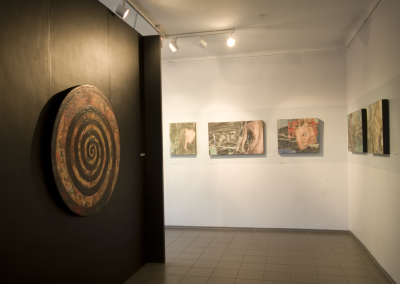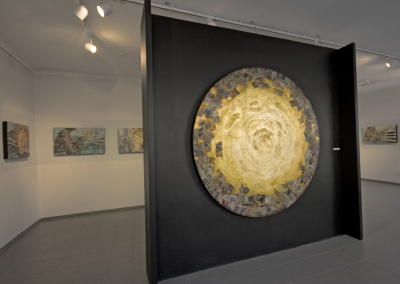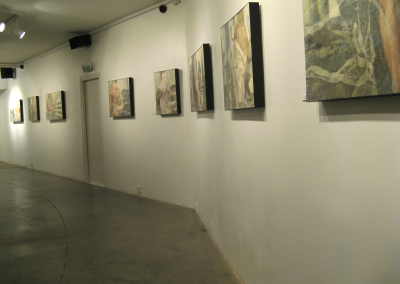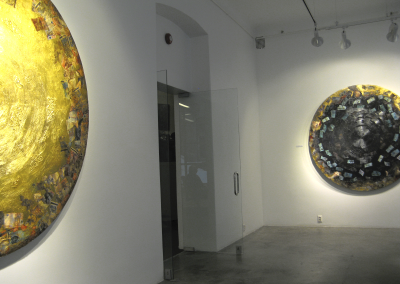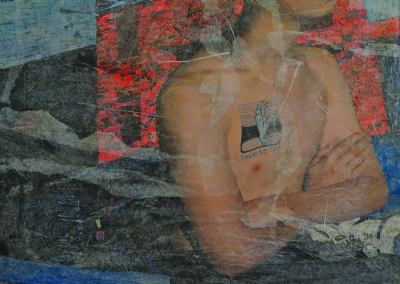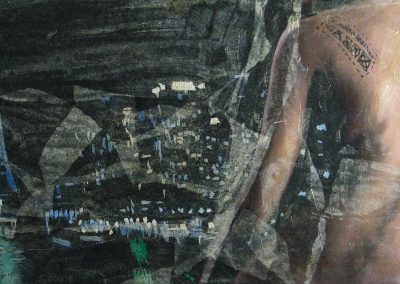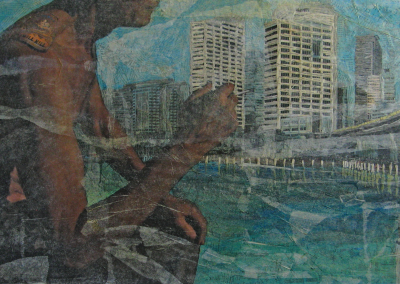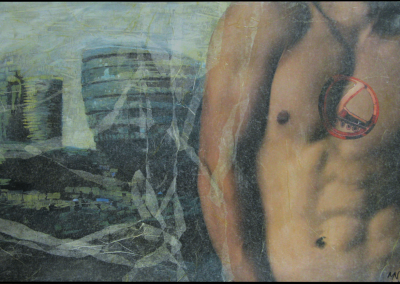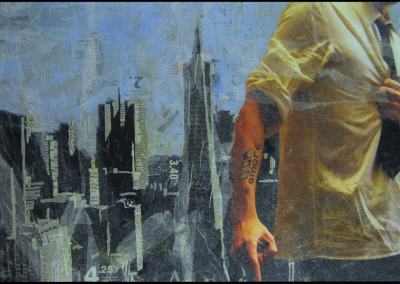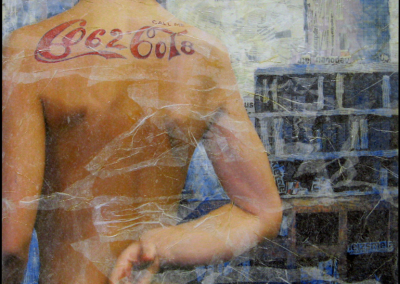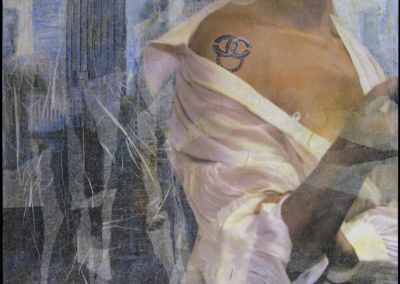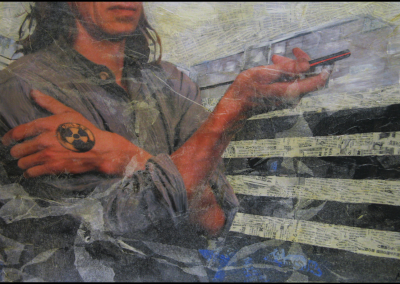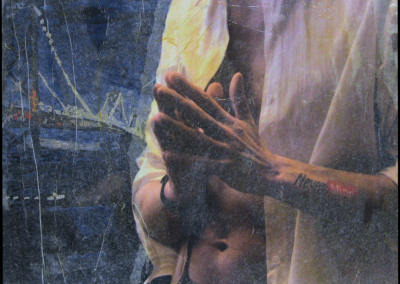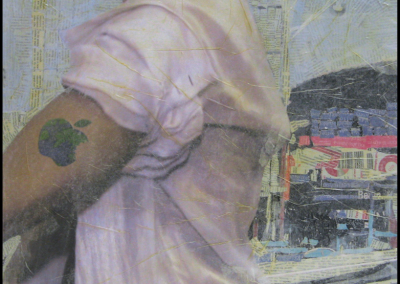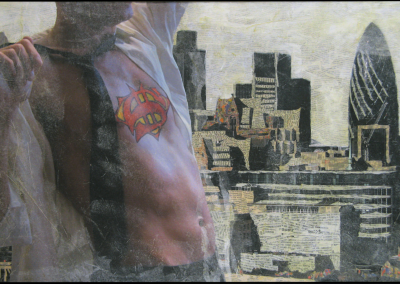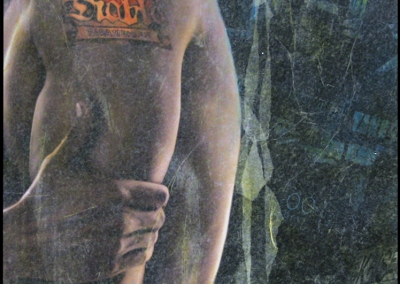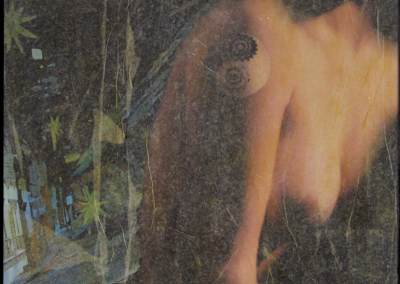„Urban Mystic“, „Urban Mystic II“
„Urban Mystic“, 2011, Hobusepea Galerii, Tallinn
„Urban Mystic II“, 2011, Tartu Kunstimaja Väike Saal
The Code of Collage
Mall Nukke’s exhibition „Urban Mystic II“ (“Linnamüstika II”) at the little gallery of Tartu Art House (20.10–27.11.2011).
For someone who’s not used to so many multivisual layers, it is almost impossible to get an overall idea or to understand the main principles, developmental tendencies and form or content variations in Mall Nukke’s works. Mall Nukke is an expert with collage and maybe it would be helpful to start with a thoughtful and formal description of her collages. I am hoping that a careful study of her work will lead every single researcher and viewer to interpret her thoughts and achievements in their own way. In this way the artist’s work could spark a cultural/spiritual dialogue and its reception would not remain merely at a superficial or external level.
At the beginning of this year, Nukke first presented her new series called „Urban Mystic“ (cf Andri Ksenofontov’s article in Sirp, 28.01.2011) at the Hobusepea Gallery, which brought together different collage materials of varying origin and demonstrated different techniques. It would be misleading to focus on the superficial similarity of these works to the Neo-Dadaist décollage of the 1950s and 60s (e.g. the works of Raymond Hains, Jacques Villeglé). That which the Neo-Dadaists and Realists used as an actual waste product of reality, an infinite remainder of the earlier layers of information, is on the other hand for Nukke a tangible and even narrative-like building material.
Newspaper-text-like collage material is used to represent the mass building of awe-inspiring metropolitan buildings, and is then also used to transform them into empty, yawning, seemingly bombed ruins; sometimes the city is shown as if it was like a model posing under strong (media) lights, and then the buildings appear to be covered in a (media) fog. The important thing is how much the artist uses the representational potential of each relevant collage technique and how much she takes that potential into account. Can a formal technique such as this transform into a relevant message? Nukke’s “Urban Mystic” literally forces you to see that the city and media are interwoven. The media is the blood, skeleton, muscle and tissue of the metropolitan human population. The city is the media.
Other collage techniques are used to add figures to this media background. The figures, or to use the correct terminology, mere half-figures or torsos, are disproportionate and look huge in the foreground. They bring to mind the image of the Statue of Liberty in New York, USA and represent the amplified human colossi of the city (media). It is intriguing that instead of using the images of megastars that have been endlessly pushed by the media and that have thus started to represent real human beings less and less, the artist uses images of Larissa and Veiko who are unknown to the general public. In her explanation, the author describes her characters as: „…heroes, divinities, they are beautiful, anonymous, strong, homogeneous, branded.“ Should we consider the fact that the artist has discarded familiar faces as a remarkable and more general change of direction in her work? It is possible that familiar media faces would have been too distinctive in the context of the concept of this series. After all, a star is an original form that loses its singularity only in the mass coverage by its followers. The logos used in the collage of the models were designed by Nukke herself, and therefore, do not have the baggage of known or famous brands. Nukke has thus muted the borders between known and unknown, amplifying anonymity on both sides.
In a compilation of articles published as „Estonian Artists 2“ by the Estonian Centre of Contemporary Arts, Johannes Saar discusses the connection between collage and the nihilist world view. I would add that Nukke’s long-practised collage work has revealed the potential of this medium of expression in many different ways; it has created curiosity as well as the hope that the artist will tirelessly keep on working and inventing. In the same way that the thus far marginal drawing has become an endlessly expressive medium in contemporary art, there are more and more amazing and substantial forms of collages to be found (for example by Haris Epaminonda).
Let us focus on the human forms in „Urban Mystic“. The viewer can see only muscular and well-proportioned torsos. Unlike in „Urban Mystic I“, Nukke mentions the idea of beauty in the explanatory text of this Tartu exhibition. This could be yet another characteristic that could help us describe the creative path of Nukke’s work. The author’s concept of beauty is intriguing. To what extent and purpose has this notion of beauty, which exists in collage after collage, been drawn from the vast differences in the human form? In reality it might not have anything to do with the author’s personal idea of beauty. Would Nukke ever create/show us her real ideal of beauty? Only if she did, would we be able to measure the extent of her current critique of beauty.
I am sure that studying Umberto Eco’s „History of Beauty“ would help us with our interpretation. I would like to point out one interesting fact – namely that until now Nukke has mostly dealt with the critique of beauty and there’s no ugliness or, to be more complex, the beauty of ugliness in her works. The anarchic text web on the pretty face of Marilyn („Portrait of a Star VI“, 2009), which also appears on the cover of Nukke’s catalogue, is definitely intended to look like an ugly rash. But for the artist this is an important and meaningful image. It gives you a direct message: star = media product. Therefore, Nukke again, turns beauty into ugliness and points out the empty shell of beauty. Eco says that from the 20th century onwards ideal beauty has been created on the basis of “an orgy of tolerance, the total syncretism and the absolute and unstoppable polytheism of beauty.” Nukke’s series „Urban Mystic“ presents us with an opposite, standardising model – one that is warning and critical. At one point Andy Warhol also included an evil destructive element in his works (allegedly thanks to the encouragement of Henry Geldzahler, curator of the Metropolitan Museum), which is why this part of his work has been compared to the war tragedies, “Desastres de la guerra” by Francisco Goya. Nukke keeps on exploring the fields of beauty, but with the aim of opening up its ugly side. It is interesting though, to think about how Nukke would deal with the phenomenon of direct ugliness.
Kaire Nurk
Mall Nukke’s “Urban Mystic”
„Urban Mystic“ („Linnamüstika“), an exhibition by Mall Nukke and Regina-Mareta Soonsein at the Hobusepea Gallery (until 31 January); painting exhibition „2011! Convert! Estonian painting“ at Rottermann’s Salt Storage (until 20 February); Mall Nukke’s exhibition at the Estonian Parliament (until 31 January).
At the moment we can see Mall Nukke’s art in three different locations.
In the gallery of the Estonian Parliament, the portraits of Kristjan Raud, Anton Hansen Tammsaare, Lydia Koidula and Carl Robert Jakobson can be seen as they were on the banknotes – in circular format. These are complemented by new Estonian currency icons. On one of those icons, the prophet Elias is flying in a chariot of fire, surrounded by a flaming circle that appears exactly like the halo used to surround the faces on Estonian money. In the prophet, we can also recognize the prophet Ilya, racing across the parking lot from the onion domes of the Nevsky cathedral, who is casting down his symbols. An Estonian hides below in a cave. Nevertheless, the game and exchange of monetary symbols on these neo-icons is restrained and efficient in a European-like manner.
Three of Mall Nukke’s paintings, depicting the landscapes on Estonian kroon notes along with the golden scratch marks of the Euro, are on show at the Rottermann Salt Storage as part of the exhibition „2011! Convert!“. Lydia Koidula of the 100 kroon banknote, was exhibited earlier this year in Haus Gallery. This painting is now complemented by a brown 5 kroon banknote demonstrating the forts of Narva, and a farmhouse courtyard from the 10 kroon banknote, painted in a strong red which is similar to the transporting fireball used by Elias/Ilya. In this exhibition the works of Mari Roosvalt, Jaan Elken, Siim-Tanel Annus, Jaan Toomik, Mall Nukke, Rauno Thomas Mossi, Maarit Murka, Laura Põllu and Veiko Klemmer combine to form a complete collection.
In the Parliament building as well as at the Rottermann Salt Storage, Mall Nukke is exhibiting her already established series of paintings. But at Hobusepea Gallery she is showing the image of two whirlpools of money from her new series, „Urban Mystic“, which has been laid out in the basement in co-operation with her daughter, a tattoo artist called Regina-Mareta Soonsein. These two whirlpools of money appear to be cosmic doorways to the mythological world of the city; they are the entrance and the exit. They depict the whirlwind of commerce and the disintegration of culture.
Mall Nukke has clearly been inspired by lettrism. The lettrists believe that all carefully constructed pieces of literature – and all other texts for that matter – have outlived their usefulness and that by tearing up the texts into many pieces and then gluing them together, new and seemingly pointless texts will be created.
Mall Nukke cuts out the signs of mass consumption that have eaten their way into our cultural tissue and then she subjects them to her games of pictoral fantasy. It’s one thing to feel like Apollo when you’re driving a Lexus, but it becomes something completely different, if you stamp the logo of a Lexus on the breasts of the neo-Apollo (with the “L” riding on rollerskates, too), as Mall Nukke has done. Or does the “L”, stolen from a Lexus, stand for lettrist instead?
„I think it’s depressing that the world appears to keep getting smaller and smaller, becoming ever more homogeneous and anonymous,“ says Mall Nukke. Arthur C. Clarke’s sci-fi novel „The City and the Stars“ left a great impression on me, as did Huxley’s „Brave New World“. Now it seems that the world is indeed moving in that direction. Most of the planet has been covered in cities and people no longer dare to leave them, because their self-preservation instincts warn them about the big unknown. In their world they are gods, outside of it they are helpless insects. Brands are like clan symbols that help people recognize alfas, betas and epsilons – it is a way of fitting in.“
I would like to point out that Mall Nukke conceived the tattoo designs, but they were actually carried out (and adjusted according to the restrictions of tattooing techniques) by Regina-Mareta Soonsein. For the first time in my life I saw a tattoo style that I would have like to have had, if I weren’t so prejudiced against it for medical reasons. To hell with famous brands, let the artist design something new for a client if they want it.
The only reason the new gods in the city – the new Olympus – would take offence would be because of a prejudice against pigs. The images have been tattooed onto fresh pigskin, then they have been photographed and finally the fragments have been pasted with the help of a photo editing program. The city, which is (veiled by layers of rice paper), is romantic and beautiful and the models are glamorous. Behind every model there is a view of some famous metropolis (London, New York, Riga) which has been glued together from pieces of text written in the respective languages. The texture of those printed text fragments, works perfectly to represent not only the texture or the patterns on the facades of industrial buildings, but it also conveys the lettrist’s… senseless nonsense.
As a country girl, Mall Nukke may not feel at home in the city, but you can see that she admires it. Ever since she started teaching art to engineering students at Tallinn University of Technology, she has developed a new interest in architecture. These images are not large, but you can feel the spaciousness, the air and the light in them. In addition, the artist has been inspired by the ultralettrist psychogeographical hypergraphy of Raymond Hains and Jacques Villeglé. This in itself is no lettrist pointlessness, but means that strollers in all the cities are followed by ancient layers of street posters that have been ripped off and glued over. People have searched for cosmic doorways into the urban mystic, в городскую мистику, to the Mustika mall from behind them. I even know some people who have been there.
Andri Ksenofontov
